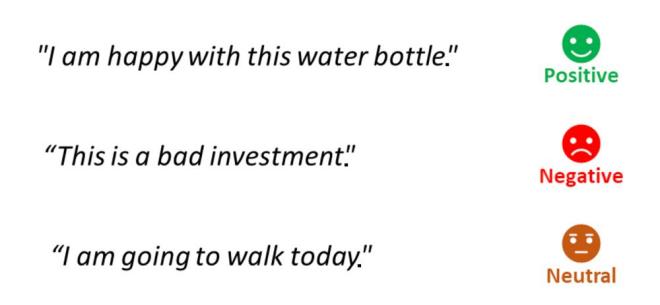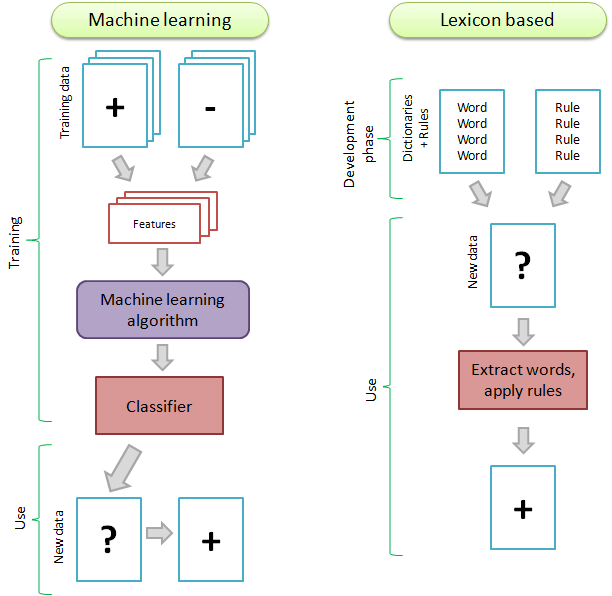Text sentiment analysis methods
Introduction to text sentiment analysis
Inputting a text,
and then the electronic system automatically feeds you what kind of sentiment
orientation the text has, whether it is positive or negative, this is text sentiment
analysis, also known as Opinion Mining. It refers to the process of collecting,
processing, analyzing, summarizing and reasoning about subjective text with emotion,
which involves various research fields such as artificial intelligence, machine
learning, data mining and natural language processing.
Text sentiment
analysis is an important branch in the field of natural language processing, which
is widely used in public opinion analysis and content recommendation, etc. It is a
hot research topic in recent years. According to the different methods used, they
are classified into sentiment analysis methods based on sentiment lexicons,
sentiment analysis methods based on traditional machine learning, and sentiment
analysis methods based on deep learning.
1. Introduction of
lexicon-based sentiment analysis methods
The method based on
sentiment lexicons refers to the division of sentiment polarity under different
granularity based on the sentiment polarity of sentiment words provided by different
sentiment lexicons.

Firstly, the text is input and pre-processed through the data (including denoising,
removing invalid characters, etc.), followed by word separation operation, then the
words of different types and degrees from the sentiment lexicons are put into the
model for training, and finally the sentiment types are output according to the
sentiment judgment rules.
Most of the existing sentiment lexicons are
constructed manually, and according to the different granularity of division, the
existing sentiment analysis tasks can be classified into word, phrase, attribute,
sentence, chapter and other levels.
Manual construction of sentiment
lexicons is costly and requires reading a large amount of relevant materials and
existing lexicons, summarizing words containing sentiment tendencies by summarizing
them and labeling them with different levels of sentiment polarity and intensity.
Advantages and disadvantages:
The sentiment
lexicon-based approach can accurately reflect the unstructured features of the text
and is easy to analyze and understand. In this method, the sentiment classification
effect is more accurate when the coverage and accuracy of sentiment words are high.
However, this method still has some defects.
The sentiment
classification method based on sentiment lexicons mainly depends on the construction
of sentiment lexicons, but due to the rapid development of the network at this stage
and the speed of information update, there are many new words on the network, and
the recognition of these new words does not work well, and the existing sentiment
lexicons need to be continuously expanded to meet the needs.
The same
sentiment word in sentiment lexicons may express different meanings at different
times, in different languages or in different domains, so the method based on
sentiment lexicons is not very effective in cross-domain and cross-language.
When using sentiment lexicons for sentiment classification, the semantic
relationships between contexts are often not considered.
Therefore more
scholars are needed to conduct sufficient research on sentiment lexicon based
methods.
2. Introduction of traditional machine learning-based
sentiment analysis methods
Machine learning is a learning
method that trains a model from given data and predicts the results by the model.
This method has been studied so far and has achieved many effective results.
Machine learning based sentiment analysis method refers to the extraction of
features through a large amount of labeled or unlabeled corpus, using statistical
machine learning algorithms, and finally outputting results in sentiment analysis.

Machine learning based sentiment classification methods are divided into three main
categories: supervised, semi-supervised and unsupervised methods.
In the supervised methods, different sentiment categories can be classified
by giving a sample set with emotional polarity. The supervised methods are more
dependent on data samples and spend more time on manual labeling and processing of
data samples. The common supervised methods are KNN, Naive Bayes and SVM.
In
semi-supervised methods, the text sentiment classification results can be
effectively improved by feature extraction from unlabeled text, and this method can
effectively solve the problem of sparse data sets with labeling.
In
unsupervised methods, unlabeled text is classified based on the similarity between
texts, and this method is less used in sentiment analysis.
Advantages
and disadvantages:
Traditional machine learning-based sentiment
classification methods mainly focus on the extraction of sentiment features and the
combination of classifiers, and the combination of different classifiers has a
certain impact on the results of sentiment analysis. These methods often cannot make
full use of the contextual information of the text, and have the problem of ignoring
the contextual semantics when analyzing the text content, so their classification
accuracy is affected.
3. Introduction of deep learning-based
sentiment analysis methods
The sentiment analysis methods based
on deep learning are performed using neural networks, and the typical neural network
learning methods are: Convolutional Neural Network (CNN), Recurrent Neural Network
(RNN), Long Short-Term Memory (LSTM) and so on.
By subdividing the deep
learning-based sentiment analysis methods, they can be divided into: single neural
network sentiment analysis methods, hybrid (combined, fusion) neural network
sentiment analysis methods, sentiment analysis by introducing attention mechanism
and sentiment analysis using pre-trained models.
1. Single neural network
sentiment analysis:
In 2003 Bengio et al. proposed a neural network
language model, which uses a three-layer feedforward neural network to model the
language. The neural network mainly consists of an input layer, a hidden
layer, and an output layer.
Each neuron in the input layer of
the network represents a trait, the number of hidden layers and hidden layer neurons
are set manually, and the output layer represents the number of categorical labels,
a basic three-layer neural network is shown below.

The essence of the language model is to predict the content of the next word
based on the contextual information without relying on the manually labeled corpus,
from which it can be found that the advantage of the language model is the ability
to learn rich knowledge from the large-scale corpus.
This approach
can effectively solve the problem of ignoring contextual semantics in
traditional sentiment analysis-based methods.
2. Sentiment
analysis by hybrid (combined, fused) neural networks:
In addition to
the research on approaches to single neural networks, a number of scholars have
combined and improved these approaches and used them in sentiment analysis after
considering the advantages of different approaches.
Compared with sentiment
analysis methods based on sentiment lexicons and traditional machine learning, the
approach using neural networks has significant advantages in text feature learning,
which can actively learn features and actively retain information about words in the
text to better extract the semantic information of the corresponding words to
effectively achieve sentiment classification of text.
As the concept of deep
learning was proposed, many researchers have continuously explored it and got a lot
of results, so the text sentiment classification methods based on deep learning are
expanding.
3. Sentiment analysis with the introduction of attention
mechanism:
Based on neural networks, in 2006, Hinton et al.
pioneered the concept of deep learning to improve the performance of learning by
learning key information in the data through deep network models to reflect the
characteristics of the data.
Deep learning-based methods use continuous,
low-dimensional vectors to represent documents and words, and thus can effectively
solve the problem of sparse data. In addition, deep learning-based methods are
end-to-end methods that automatically extract text features and reduce the
complexity of text construction features.
Deep learning methods have made
significant progress in the field of natural language processing, such as machine
translation, text classification, and entity recognition, in addition to remarkable
results in the fields of speech and image. The research on text sentiment analysis
methods belongs to a small branch of text classification.
By adding
attention mechanism to deep learning methods for sentiment analysis tasks, it can
better capture contextually relevant information, extract semantic information and
prevent the loss of important information, which can effectively improve the
accuracy of text sentiment classification.
The current stage of research is
more about fine-tuning and improving the pre-training model so as to enhance the
experiments more effectively.
4. Sentiment analysis using pre-trained
models:
A pre-trained model is a model that has been trained with a
dataset. By fine-tuning the pre-trained model, better sentiment classification
results can be achieved, so most of the latest methods use pre-trained models, and
the latest pre-trained models are: ELMo, BERT, XL-NET, ALBERT, etc.
By
making full use of the large-scale monolingual corpus compared with the traditional
methods, the pre-training method using language models can model multiple meanings
of a word, and the process of pre-training using language models can be regarded as
a sentence-level contextual word representation.
By pre-training a
large-scale corpus using a unified model or adding features to some simple models,
good results have been achieved in many NLP tasks, indicating that this approach is
significantly effective in alleviating the problem of reliance on model structure.
There will be more research on natural language processing tasks in the
future, especially on sentiment mining of text. Most of the latest approaches to
sentiment analysis are based on fine-tuning of pre-trained models and have achieved
good results.
Therefore, it can be predicted that future sentiment
analysis methods will focus more on researching deep learning-based methods and
achieving better sentiment analysis results by fine-tuning the pre-training
models.
Conclusion
Through the
introduction of the previous articles, we can predict that the use of deep learning
for sentiment analysis is a future research trend in the field of natural language
processing, where the scale of text data is expanding. From the development trend of
different methods, future research on text sentiment analysis needs to focus on the
following aspects:
1. By comparing different research methods, we can find
that the existing research methods for sentiment analysis are mostly based on a
single domain, such as social media Twitter, hotel reviews, etc.. In personalized
recommendation, how to combine the content of multiple domains, perform sentiment
classification, achieve better recommendation effect, and achieve in improving the
generalization performance of the model are all worthy of future research and
exploration.
2. Most of the research on sentiment analysis is mostly used
for explicit text sentiment classification problems, using data sets containing
obvious sentiment words, while the detection and classification of certain implicit
words is not effective. At this stage, the research on implicit sentiment analysis
is still in the initial stage and not very adequate. In the future, better sentiment
classification can be achieved by building an implicit sentiment lexicon or by using
better deep learning methods to extract semantic related information in a deeper
way.
3. Research on sentiment analysis of complex utterances needs to be
further improved. When online phrases with sentiment tendency appear more and more
frequently, especially when the text contains ironic or metaphorical words, the
detection of sentiment polarity will be difficult, which also needs further
research.
4. Multimodal sentiment analysis is also a recent research
hotspot. How to extract and fuse the sentiment information in multiple modalities is
the main research direction. When the sentiment expressions in multiple modalities
are inconsistent, how to weight the sentiment information in different modalities
also needs to be considered; and whether external semantic information can be
considered, and whether it is helpful to the accuracy of sentiment analysis, also
needs to have a lot of research.
5. In the sub-task of sentiment analysis,
it can also be found that most of the research is based on simple binary sentiment
analysis, and achieving multi-categorization and more fine-grained sentiment
analysis is also a hot topic for future research.
6. Pre-training model is a
hot research topic at this stage. It can effectively solve the problems of
traditional methods, such as the limitation of not being able to parallelize the
computation, and can also effectively capture the interrelationship between words
and achieve better results in downstream tasks by fine-tuning. However, it also
suffers from the problem of large number of model parameters and long training time.
How to achieve good classification results with a small number of model parameters
and effectively shorten the training time would also be a direction worth studying.